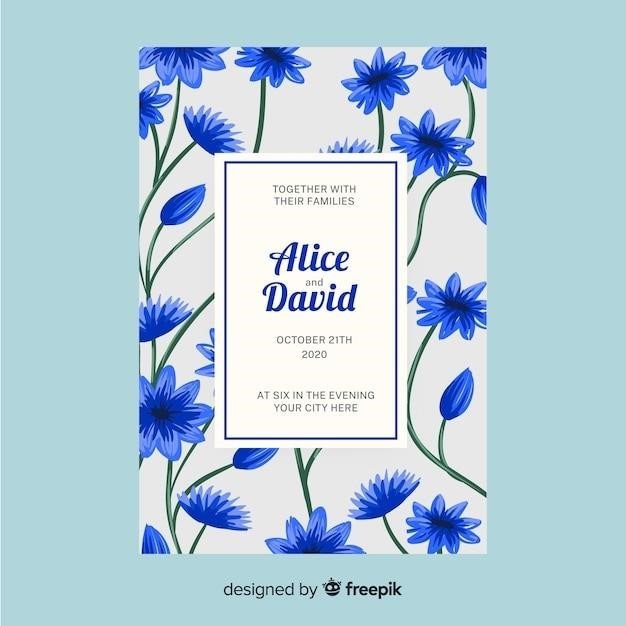Bluets by Maggie Nelson⁚ A Lyrical Exploration of Blue
Bluets is a 2009 book by American author Maggie Nelson, published by Wave Books. The work hybridizes several prose and poetry styles as it documents Nelson’s multifaceted experience with the color blue, and is often referred to as a lyric essay or prose poetry.
A Brief Overview of Bluets
Bluets is a unique and captivating work that defies easy categorization. It’s not a traditional memoir, nor is it a straightforward philosophical treatise. Instead, it’s a hybrid form that blends elements of autobiography, poetry, and critical theory, all woven together through the unifying thread of the color blue. The book is structured as a series of numbered entries, each exploring a different facet of the author’s relationship with blue, both on a personal and intellectual level.
Nelson delves into the complexities of blue, exploring its symbolic meanings across cultures and throughout history. She examines its associations with sadness, melancholy, and loss, but also with beauty, serenity, and the vastness of the sky and ocean. As she unravels the layers of meaning embedded in this single color, she reveals deeper truths about love, loss, grief, and the human condition.
Bluets is a deeply personal exploration of the author’s own experiences with depression, love, and the limitations of language. It’s a book that invites readers to engage with their own emotions and perceptions, prompting them to consider the ways in which color, and art in general, can shape our understanding of the world.
Maggie Nelson’s Writing Style and Themes
Maggie Nelson’s writing is characterized by its lyrical quality, its intellectual depth, and its willingness to embrace vulnerability. In Bluets, she seamlessly blends personal reflection with scholarly insights, weaving together threads of autobiography, philosophy, art criticism, and cultural theory. Her prose is both poetic and analytical, often employing aphorisms and fragmented sentences to capture the elusive nature of thought and emotion.
Nelson’s work frequently grapples with themes of love, loss, grief, and the complexities of human relationships. She explores these themes with honesty and raw emotion, never shying away from difficult questions about desire, pain, and the fragility of the human heart.
Beyond the personal, Nelson also delves into broader societal issues related to gender, sexuality, and representation. She examines the ways in which language and culture shape our understanding of the world, and how these forces can both empower and limit human experience. Her writing is a testament to the power of language to both express and interrogate the complexities of life.
The Color Blue as a Metaphor
In Bluets, the color blue transcends its literal hue, becoming a multifaceted metaphor for a wide range of emotions, experiences, and ideas. Nelson uses blue as a lens through which to examine the complexities of love, loss, and the human condition. Blue becomes a symbol of longing, sadness, and the vastness of the unknown.
It evokes feelings of melancholy and introspective reflection, representing the depths of human emotion and the mysteries of the soul. Nelson draws connections between blue and the color of the sky, the ocean, and the veins in our bodies, highlighting the interconnectedness of all things and the universal nature of human experience.
The color blue also serves as a metaphor for the limitations of language and the struggle to express ineffable emotions. Nelson acknowledges the inadequacy of words to fully capture the nuances of human experience, using the color blue as a means of exploring the boundaries of expression and the challenges of articulating the unsaid.
Key Themes Explored in Bluets
Bluets delves into a constellation of themes that resonate with readers on a deeply personal level, inviting reflection on the complexities of human experience. Nelson weaves together a tapestry of ideas and emotions, exploring the depths of love, loss, and the human condition.
The book grapples with the universality of pain and suffering, acknowledging the shared experience of grief and the enduring impact of loss. Nelson’s exploration of these themes is both intimate and universal, drawing on her own personal experiences to illuminate the human capacity for resilience and the profound impact of heartbreak.
Bluets also examines the nature of perception and the subjective experience of reality. Nelson challenges the reader to consider how our perceptions of the world are shaped by our individual histories, beliefs, and biases. The color blue becomes a vehicle for exploring the limitations of our senses and the ways in which our understanding of the world is constantly evolving.
Love, Loss, and Grief
At its core, Bluets is a poignant exploration of love, loss, and the profound impact of grief on the human psyche. Nelson’s prose is imbued with a raw vulnerability as she delves into the complexities of romantic relationships, the bittersweet nature of love, and the enduring pain of heartbreak.
Through the lens of the color blue, Nelson examines the ways in which love can both uplift and devastate, illuminating the intricate dance between joy and sorrow that often characterizes romantic attachments. She explores the transformative power of love, its ability to both heal and wound, and the challenges of navigating the delicate balance between intimacy and independence.
The book also grapples with the experience of loss, the profound impact of grief, and the enduring nature of memory. Nelson’s words resonate with readers who have experienced the pain of losing someone they love, offering a space for reflection and understanding. She explores the ways in which grief can manifest itself, from physical pain and emotional turmoil to the lingering presence of the departed.
Depression and Mental Health
Bluets delves into the complexities of depression and mental health with an unflinching honesty that resonates deeply with readers who have experienced similar struggles. Nelson’s prose captures the lived experience of depression, its overwhelming darkness, and the profound impact it has on everyday life.
The book explores the cyclical nature of depression, the ebb and flow of its intensity, and the challenges of navigating the emotional landscape of mental illness. Nelson’s words offer a glimpse into the internal world of someone struggling with depression, capturing the feelings of isolation, despair, and self-doubt.
Through her exploration of blue, Nelson examines the ways in which depression can manifest itself physically, emotionally, and psychologically. She explores the connection between mental health and physical sensations, the impact of depression on relationships, and the challenges of seeking help and finding support. By sharing her own struggles with depression, Nelson provides a space for readers to feel seen and understood, offering a sense of solidarity and hope.
The Power of Language
Nelson’s exploration of blue is not only a personal journey but also a profound meditation on the power of language. She recognizes the inherent limitations of language, its inability to fully capture the complexities of human experience, yet she embraces its potential to create meaning, evoke emotions, and forge connections.
Bluets is a testament to the transformative power of language. Nelson uses words to explore the nuances of grief, the depths of despair, and the elusiveness of love. She weaves together personal anecdotes, philosophical musings, and literary references, creating a tapestry of language that reflects the richness and complexity of her subject matter;
Through her exploration of blue, Nelson demonstrates how language can be a tool for self-discovery, healing, and understanding. She acknowledges the limitations of language while simultaneously celebrating its capacity to create meaning, connect us to others, and offer solace in times of pain. Bluets is a testament to the enduring power of language to shape our perceptions, articulate our emotions, and ultimately, to make sense of the world around us.

The Nature of Perception
Nelson’s exploration of blue delves into the subjective nature of perception, challenging readers to consider how our individual experiences shape our understanding of the world. She emphasizes that color is not an objective reality but rather a product of our senses, our cultural background, and our personal history.
Through her exploration of blue, Nelson invites us to question our assumptions about perception. She suggests that what we see is not necessarily what exists, but rather a reflection of our own internal world. She challenges us to consider the role of memory, emotion, and personal history in shaping our perceptions, demonstrating how our individual experiences can profoundly influence our understanding of color.
Nelson’s exploration of blue is ultimately a meditation on the subjective nature of perception. She reminds us that color is not a fixed entity but rather a fluid, ever-shifting experience that is shaped by our individual perspectives. By inviting us to consider the complexities of perception, Nelson encourages us to embrace the subjective nature of our experiences and to recognize the power of individual interpretation.
Critical Reception and Influence
Bluets has garnered widespread critical acclaim, praised for its lyrical prose, its exploration of complex themes, and its unique hybrid form. Reviewers have commended Nelson’s ability to weave together personal reflection, philosophical inquiry, and cultural critique into a compelling and moving narrative. The book has been lauded for its originality, its emotional depth, and its ability to resonate with readers on a personal level.
Bluets has been influential in shaping the landscape of contemporary non-fiction, inspiring a new generation of writers to explore personal experience through creative and experimental forms. The book has been cited as a key example of the lyric essay, a genre that blends personal narrative with literary and philosophical reflection. It has also been influential in expanding the scope of non-fiction writing, demonstrating the power of personal experience to illuminate complex issues and to challenge readers to think critically about the world around them.
Bluets has been widely read and discussed, and its influence can be seen in the work of numerous contemporary writers. The book continues to inspire and challenge readers, offering a unique and insightful exploration of the complexities of human experience. It has become a touchstone for writers and readers alike, demonstrating the power of personal narrative to explore universal themes and to provoke meaningful dialogue.
Where to Find Bluets
Bluets is widely available in both physical and digital formats. You can find it at most major bookstores, both online and in person. Online retailers such as Amazon, Barnes & Noble, and Bookshop.org offer Bluets in paperback and e-book versions. You can also find it at independent bookstores and local libraries.
If you’re looking for a digital version, Bluets is available on platforms like Kindle, Nook, and Kobo. Additionally, many libraries offer Bluets as part of their digital collections, making it accessible to readers with a library card. If you’re interested in purchasing a physical copy, consider supporting local bookstores by browsing their selection or ordering online.
Beyond traditional bookstores, you can also find Bluets at used book shops and online platforms like eBay and ThriftBooks. These options often offer affordable copies of the book, making it accessible to readers on a budget. No matter your preferred format or budget, Bluets is readily available and easily accessible to anyone interested in exploring its lyrical exploration of the color blue.
Further Reading and Resources
For those wanting to delve deeper into Maggie Nelson’s work or explore related themes, there are several avenues to pursue. Nelson’s other books, such as “The Argonauts” and “The Art of Cruelty,” offer further insights into her writing style and the intersection of autobiography, art, and theory. You can find interviews with Nelson, essays about her work, and book reviews in various literary publications.
Additionally, exploring works by other writers who utilize lyric essay or prose poetry can provide a broader context for understanding Bluets. Consider authors such as Leslie Jamison, Eula Biss, and Vivian Gornick, whose works engage with personal experiences and philosophical inquiries in innovative ways. For a deeper understanding of the color blue and its cultural significance, exploring art history, philosophy, and psychology resources can offer valuable insights.
Online resources such as websites dedicated to literary criticism, academic databases, and online journals can provide access to scholarly articles and essays that delve into the themes and techniques employed in Bluets. Engaging with these resources can enrich your understanding of the book and its place within contemporary literature.




Be the first to reply